Inversion of Soil Heavy Metal Content Based on Spectral Characteristics of Peach Trees
Abstract
:1. Introduction
2. Materials and Methods
2.1. Study Area
2.2. Data Acquisition
2.2.1. Peach Leaf Reflectance Spectrum Acquisition
2.2.2. Soil Sample Collection and Heavy Metal Content Determination
2.3. Construction of Spectral Index
2.4. Correlation Analysis
2.5. Modeling Method
2.5.1. Univariate Linear Regression Model
2.5.2. Multiple Linear Regression Model
2.6. Model Accuracy Evaluation
3. Results
3.1. Statistical Characteristics of Soil Heavy Metal Content
3.2. Spectral Response of Peach Tree Leaves to Soil Heavy Metals
3.3. Correlation Analysis of Soil Heavy Metals and Spectral Reflectance
3.4. Correlation Analysis of Soil Heavy Metals and Spectral Index
3.5. Modeling and Accuracy Verification
3.5.1. Prediction Model of Heavy Metal Elements Based on Single Variable
3.5.2. Prediction Model of Heavy Metal Elements Based on Multivariate
3.5.3. Prediction Model of Heavy Metal Elements Based on Multivariate
4. Discussion
5. Conclusions
- (1)
- Under different levels of heavy metal contamination, the trends of the reflectance spectral curves for the peach leaves were generally consistent, and the reflectance in the contaminated areas was generally higher than that in the background areas. There was a more obvious difference in the wavelength range of 760–1300 nm, which is relatively sensitive to the response of heavy metals in the soil. The heavy metals did not interfere significantly with the spectral positions of the red, blue, and yellow edges of the leaves, but they responded very obviously to the slopes of the three edges, which all increased with an increased heavy metal content.
- (2)
- The correlations were weak and insignificant between the soil Cr, Cu, and Hg and spectral reflectance. The As, Pb, and Cd in the soil had strong correlations in some wavelength ranges, and the overall trends of the correlation curves were consistent. In comparison, the correlation between the soil heavy metal elements and the differential spectral indices was greater, with correlation coefficients all greater than 0.65. Subsequently, we used SPSS data analysis software to establish a one-dimensional linear regression model of different heavy metal elements and indices, and it was found that the accuracy of the model was moderately accurate and not quite stable.
- (3)
- The study used five variables (blue band, red band, long-wave NIR, difference index, and normalized index) as independent variables and selected the soil heavy metal elements (As, Pb, and Cd) with a stronger correlation and significance to establish the multiple linear regression model. We randomly selected 20 sample points to test the prediction model for each of the three elements, and we evaluated the accuracy of the model inversion using the R2 and RMSE. In particular, the inversion accuracy of Pb was the highest and Cd was the lowest. The overall reproduction accuracy (R2) of the model is greater than 0.8 and the RMSE is less than 5, which indicates that the predictive inversion model can effectively estimate the contents of As, Pb, and Cd.
Author Contributions
Funding
Data Availability Statement
Conflicts of Interest
Appendix A




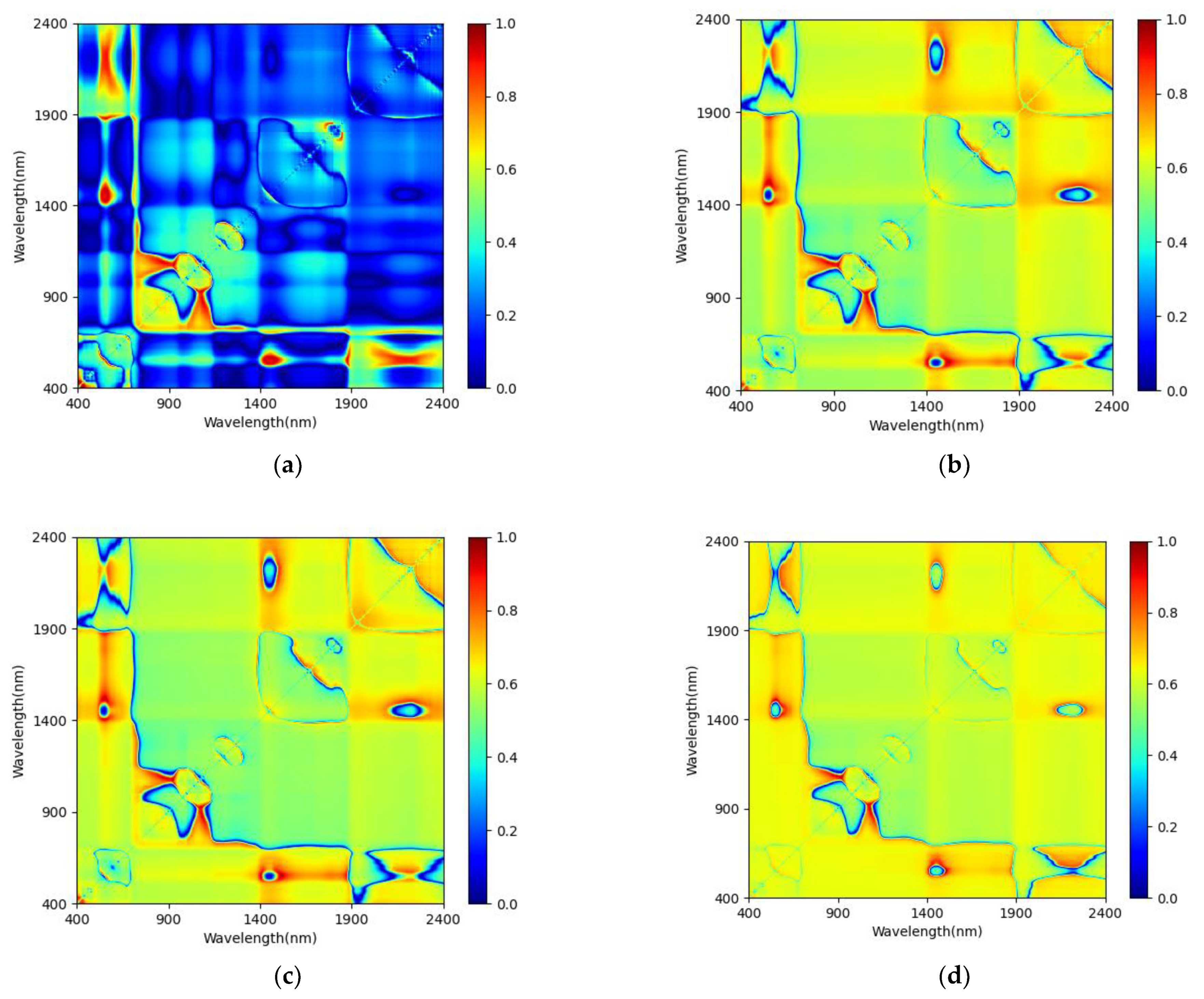
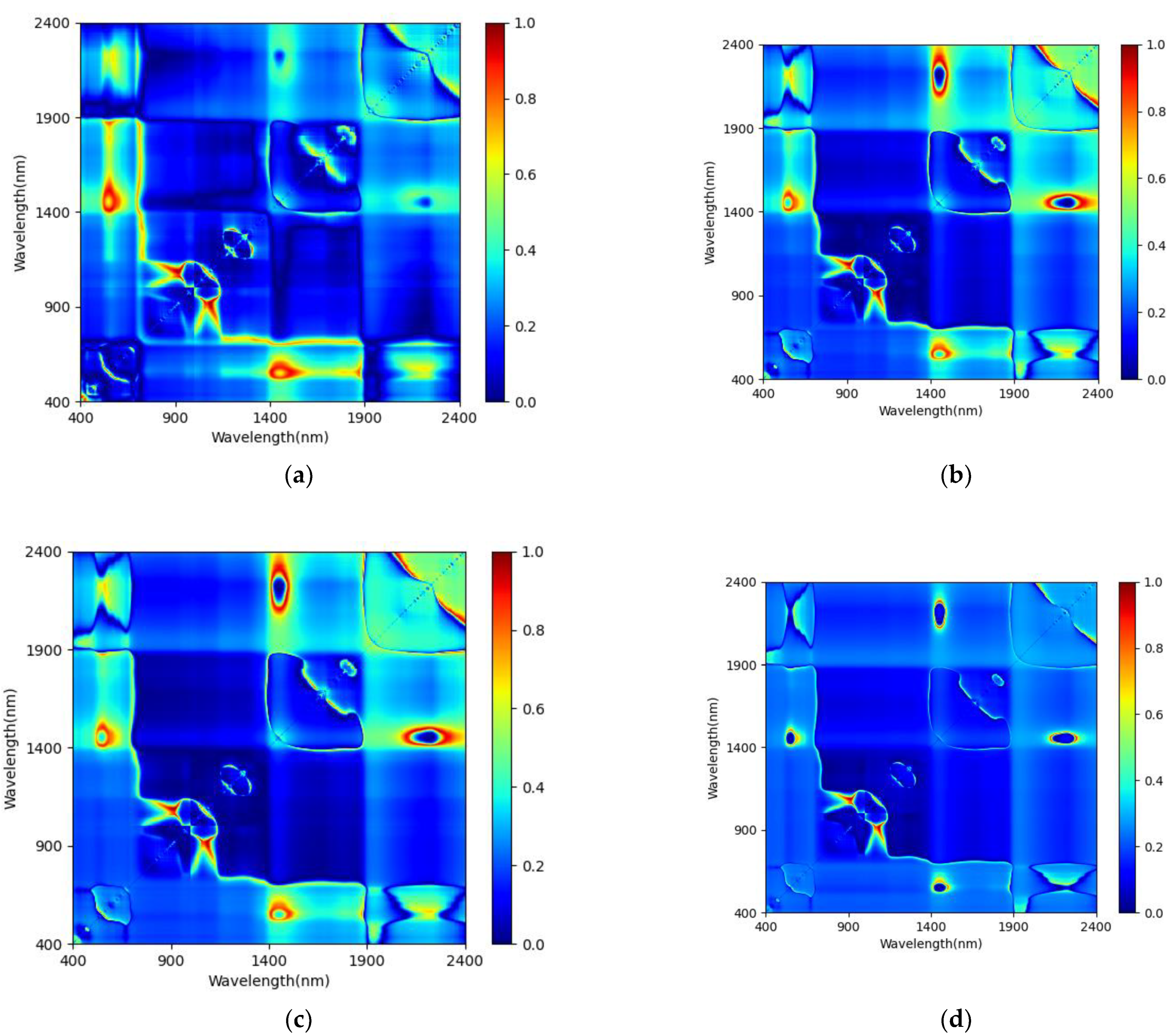


References
- Zhuang, G. Status of soil pollution in China and prevention and control strategies. Proc. Chin. Acad. Sci. 2015, 30, 477–483. [Google Scholar]
- Zhao, F.J.; Ma, Y.; Zhu, Y.G.; Tang, Z.; McGrath, S.P. Soil Contamination in China: Current Status and Mitigation Strategies. Environ. Sci. Technol. 2015, 49, 750. [Google Scholar] [CrossRef]
- Long, X.; Yang, X.; Ni, W. Status and prospects of remediation technology for heavy metal contaminated soil. J. Appl. Ecol. 2002, 13, 757–762. [Google Scholar]
- Deng, F.; Yu, S.Y.; Zhu, M.J. Overview of soil pollution status and monitoring methods. Green Technol. 2019, 16, 181–183. [Google Scholar]
- Zheng, W.; Yi, Z.; Shen, G. Evaluation of water environmental carrying capacity and pollution risk of agricultural production in China. Soil Water Conserv. Bull. 2017, 37, 261–267. [Google Scholar]
- Nawab, J.; Khan, S.; Shah, M.T.; Gul, N.; Ali, A.; Khan, K.; & Huang, Q. Heavy Metal Bioaccumulation in Native Plants in Chromite Impacted Sites: A Search for Effective Remediating Plant Species. Clean-Soil Air Water 2016, 44, 37–46. [Google Scholar] [CrossRef]
- Williams, C.H.; David, D.J. The Accumulation In Soil Of Cadmium Residues From Phosphate Fertilizers And Their Effect On The Cadmium Content Of Plants. Soil Sci. 1976, 121, 86–93. [Google Scholar] [CrossRef]
- Merry, R.H.; Tiller, K.G.; Alston, A.M. The effects of contamination of soil with copper, lead and arsenic on the growth and composition of plants. Plant Soil 1986, 91, 115–128. [Google Scholar] [CrossRef]
- Zhang, W.W.; Yang, K.M.; Xia, X.; Liu, C.; Sun, T.T. Correlation analysis of spectral fractional order differentiation with heavy metal copper content in maize leaves. Sci. Technol. Eng. 2017, 17, 33–38. [Google Scholar]
- Chi, G.Y.; Liu, X.H.; Liu, S.U.H.; Yang, Z.F. Study on the correlation between Cu contamination and characteristic spectra of wheat. Spectrosc. Spectr. Anal. 2006, 4, 1272–1276. [Google Scholar]
- Yang, K.; Gao, W.; Chen, C.; Zhao, H.; Han, Q.; Li, Y. Hyperspectral identification of copper and lead stress in maize leaves. J. Agric. Mach. 2021, 52, 215–222. [Google Scholar]
- Arao, T.; Ishikawa, S.; Murakami, M.; Abe, K.; Maejima, Y.; Makino, T. Heavy metal contamination of agricultural soil and countermeasures in Japan. Paddy Water Environ. 2010, 8, 247–257. [Google Scholar] [CrossRef]
- Duan, G.; Shao, G.; Tang, Z.; Chen, H.; Wang, B.; Tang, Z.; Yang, Y.; Liu, Y.; Zhao, F.J. Genotypic and Environmental Variations in Grain Cadmium and Arsenic Concentrations Among a Panel of High Yielding Rice Cultivars. Rice 2017, 10, 1–13. [Google Scholar] [CrossRef] [Green Version]
- Tan, K.; Ma, W.; Chen, L.; Wang, H.; Du, Q.; Du, P.; Yan, B.; Liu, R.; Li, H. Estimating the Distribution Trend of Soil Heavy Metals in Mining Area from HyMap Airborne Hyperspectral Imagery Based on Ensemble Learning. J. Hazard. Mater. 2020, 401, 123288. [Google Scholar] [CrossRef]
- Zhang, B.; Wu, D.; Zhang, L.; Jiao, Q.; Li, Q. Application of hyperspectral remote sensing for environment monitoring in mining areas. Environ. Earth Sci. 2012, 65, 649–658. [Google Scholar] [CrossRef]
- Yang, X.; Lei, S.; Zhao, Y.; & Cheng, W. Use of hyperspectral imagery to detect affected vegetation and heavy metal polluted areas: A coal mining area, China. Geocarto Int. 2020, 2, 1–20. [Google Scholar] [CrossRef]
- Chen, T.; Chang, Q.; Clevers, J.G.P.W.; Kooistra, L. Rapid identification of soil cadmium pollution risk at regional scale based on visible and near-infrared spectroscopy. Environ. Pollut. 2015, 206, 217–226. [Google Scholar] [CrossRef]
- Xue, Y.; Zou, B.; Wen, Y.; Tu, Y.; Xiong, L. Hyperspectral Inversion of Chromium Content in Soil Using Support Vector Machine Combined with Lab and Field Spectra. Sustainability 2020, 12, 4441. [Google Scholar] [CrossRef]
- Li, H.; Wei, Z.; Wang, X.; Xu, F. Spectral Characteristics of Reclaimed Vegetation in a Rare Earth Mine and Analysis of its Correlation with the Chlorophyll Content. J. Appl. Spectrosc. 2020, 87, 553–562. [Google Scholar] [CrossRef]
- Lu, Q.; Wang, S.; Bai, X.; Liu, F.; Wang, M.; Wang, J.; Tian, S. Rapid inversion of heavy metal concentration in karst grain producing areas based on hyperspectral bands associated with soil components. Microchem. J. 2019, 148, 404–411. [Google Scholar] [CrossRef]
- Guan, F.Y.; Deng, W.H. Spectral characteristics of Phyllostachys pubescens stand and its differential analysis with typical vegetation. J. Beijing For. Univ. 2012, 34, 31–35. [Google Scholar]
- Cheng, H.; Shen, R.; Chen, Y.; Wan, Q.; Shi, T.; Wang, J.; Wang, Y.; Hong, Y.; Li, X. Estimating heavy metal concentrations in suburban soils with reflectance spectroscopy. Geoderma 2019, 336, 59–67. [Google Scholar] [CrossRef]
- Shi, R.J.; Pan, X.Z.; Wang, C.K.; Liu, Y.; Li, Y.L.; Li, Z.T. Prediction of Cadmium Content in the Leaves of Navel Orange in Heavy Metal Contaminated Soil Using VIS-NIR Reflectance Spectroscopy. Spectrosc. Spectr. Anal. 2015, 35, 3140–3145. [Google Scholar]
- Kooistra, L.; Salas, E.A.L.; Clevers, J.G.P.W.; Wehrens, R.; Leuven, R.S.E.W.; Nienhuis, P.H.; Buydens, L.M.C. Exploring field vegetation reflectance as an indicator of soil contamination in river floodplains. Environ. Pollut. 2004, 127, 281–290. [Google Scholar] [CrossRef]
- Zhao, S.Y.; Zhang, J.; Ni, C.Y.; Fu, W.C.; Hao, J.C. Effects of soil heavy metal pollution on rice hyperspectrum. Jiangsu Agric. Sci. 2016, 44, 423–426. [Google Scholar]
- Zhou, W.; Yang, H.; Xie, L.; Li, H.; Huang, L.; Zhao, Y.; Yue, T. Hyperspectral inversion of soil heavy metals in Three-River Source Region based on random forest model. Catena 2021, 202, 105222. [Google Scholar] [CrossRef]
- Shi, T.; Chen, Y.; Liu, Y.; Wu, G. Visible and near-infrared reflectance spectroscopy-An alternative for monitoring soil contamination by heavy metals. J. Hazard. Mater. 2014, 265, 166–176. [Google Scholar] [CrossRef]
- Liu, Y.; Jiang, Q.; Shi, T.; Fei, T.; Wang, J.; Liu, G.; Chen, Y. Prediction of total nitrogen in cropland soil at different levels of soil moisture with Vis/NIR spectroscopy. Acta Agric. Scand. 2014, 64, 267–281. [Google Scholar] [CrossRef]
- Zhao, T.; Wang, A.; Xia, J.; Liu, S. A study on the spectral response of leaf characteristics of five knotted mangoes in the heavy metal pollution area of Cook River Basin. Remote. Sens. Land Resour. 2010, 2, 49–54. [Google Scholar]
- Lassalle, G.; Fabre, S.; Credoz, A.; Hédacq, R.; Borderies, P.; Bertoni, G.; Erudel, T.; Buffan-Dubau, E.; Dubucq, D.; Elger, A. Detection and discrimination of various oil-contaminated soils using vegetation reflectance. Sci. Total Environ. 2018, 655, 1113–1124. [Google Scholar] [CrossRef] [Green Version]
- Bashir, S.M.A.; Wang, Y. Small Object Detection in Remote Sensing Images with Residual Feature Aggregation-Based Super-Resolution and Object Detector Network. Remote Sens. 2021, 13, 1854. [Google Scholar] [CrossRef]
- Shi, T.; Liu, H.; Chen, Y.; Wang, J.; Wu, G. Estimation of arsenic in agricultural soils using hyperspectral vegetation indices of rice. J. Hazard. Mater. 2016, 308, 243–252. [Google Scholar] [CrossRef] [PubMed]
- Lassalle, G.; Fabre, S.; Credoz, A.; Hédacq, R.; Bertoni, G.; Dubucq, D.; Elger, A. Application of PROSPECT for estimating Total Petroleum Hydrocarbons in contaminated soils from leaf optical properties. J. Hazard. Mater. 2019, 377, 409–417. [Google Scholar] [CrossRef] [Green Version]
- Ouyang, X.; Sun, J. Monitoring and Evaluation of Environmental Quality of Agricultural Products Producing Area; China Agriculture Press: Beijing, China, 2013. [Google Scholar]
- State Environmental Protection Bureau; State Technical Supervision Bureau. GB 15618-1995 Soil Environmental Quality Standard; China Standard Publishing House: Beijing, China, 1995. [Google Scholar]
- Zhu, J.; Wei, J.; Wang, H.; Yao, J.; Qin, G.; Xu, C.; Huang, T. Spectral characteristics of Populus grandis and its leaf functional traits in response to foliar dustfall. Spectrosc. Spectr. Anal. 2020, 40, 1620–1625. [Google Scholar]
- Cotrozzi, L.; Couture, J.J.; Cavender-Bares, J.; Kingdon, C.C.; Fallon, B.; Pilz, G.; Pellegrini, E.; Nali, C.; Townsend, P.A. Using foliar spectral properties to assess the effects of drought on plant water potential. Tree Physiol. 2017, 37, 1582–1591. [Google Scholar] [CrossRef]
- Jiang, P. Chemometric Characteristics of Leaf and Apoplastic C, N, and P in Forest Ecosystems of Shaanxi Province; Northwest Agriculture and Forestry University: Shanxi, China, 2016. [Google Scholar]
- Liu, J.Y. Simulation and Prediction of Net Primary Productivity of Forest Ecosystems in the Qinling Mountains; Northwestern University: Shanxi, China, 2019. [Google Scholar]
- Pingrong, L.I. Data Mining Technology and its Applications in Big data Era. J. Chongqing Three Gorges Univ. 2014, 30, 45–47. [Google Scholar]
- Zhou, C.; Chen, S.; Zhang, Y.; Zhao, J.; Song, D.; Liu, D. Evaluating Metal Effects on the Reflectance Spectra of Plant Leaves during Different Seasons in Post-Mining Areas, China. Remote Sens. 2018, 10, 1211. [Google Scholar] [CrossRef] [Green Version]
- Huang, S.S.; Liao, Q.L.; Hua, M.; Wu, X.M.; Bi, K.S.; Yan, C.Y.; Chen, B.; Zhang, X.Y. Survey of heavy metal pollution and assessment of agricultural soil in Yangzhong district, Jiangsu Province, China. Chemosphere 2007, 67, 2148–2155. [Google Scholar] [CrossRef]
- Xu, X.H.; Ji, C.L. Heavy metal pollution survey of vegetable soil in Jiangsu Province and the countermeasures. Rural Eco-Environ. 2005, 21, 35–37. [Google Scholar]
- Douay, F.; Roussel, H.; Fourrier, H.; Heyman, C.; Chateau, G. Investigation of heavy metal concentrations on urban soils, dust and vegetables nearby a former smelter site in Mortagne du Nord, Northern France. J. Soils Sediments 2007, 7, 143–146. [Google Scholar] [CrossRef]
- Mallmann, F.J.K.; dos Santos Rheinheimer, D.; Ceretta, C.A.; Cella, C.; Minella, J.P.G.; Guma, R.L.; Filipović, V.; van Oort, F.; Šimůnek, J. Soil tillage to reduce surface metal contamination—Model development and simulations of zinc and copper concentration profiles in a pig slurry-amended soil. Agric. Ecosyst. Environ. 2014, 196, 59–68. [Google Scholar] [CrossRef] [Green Version]
- Zhang, S.; Shen, Q.; Nie, C.; Huang, Y.; Wang, J.; Hu, Q.; Ding, X.; Zhou, Y.; Chen, Y. Hyperspectral inversion of heavy metal content in reclaimed soil from a mining wasteland based on different spectral transformation and modeling methods. Spectrochim. Acta Part A Mol. Biomol. Spectrosc. 2018, 211, 393–400. [Google Scholar] [CrossRef] [PubMed]
- Shen, Q.; Xia, K.; Zhang, S.; Kong, C.; Hu, Q.; Yang, S. Hyperspectral indirect inversion of heavy-metal copper in reclaimed soil of iron ore area. Spectrochim. Acta Part A Mol. Biomol. Spectrosc. 2019, 222, 117191. [Google Scholar] [CrossRef] [PubMed]

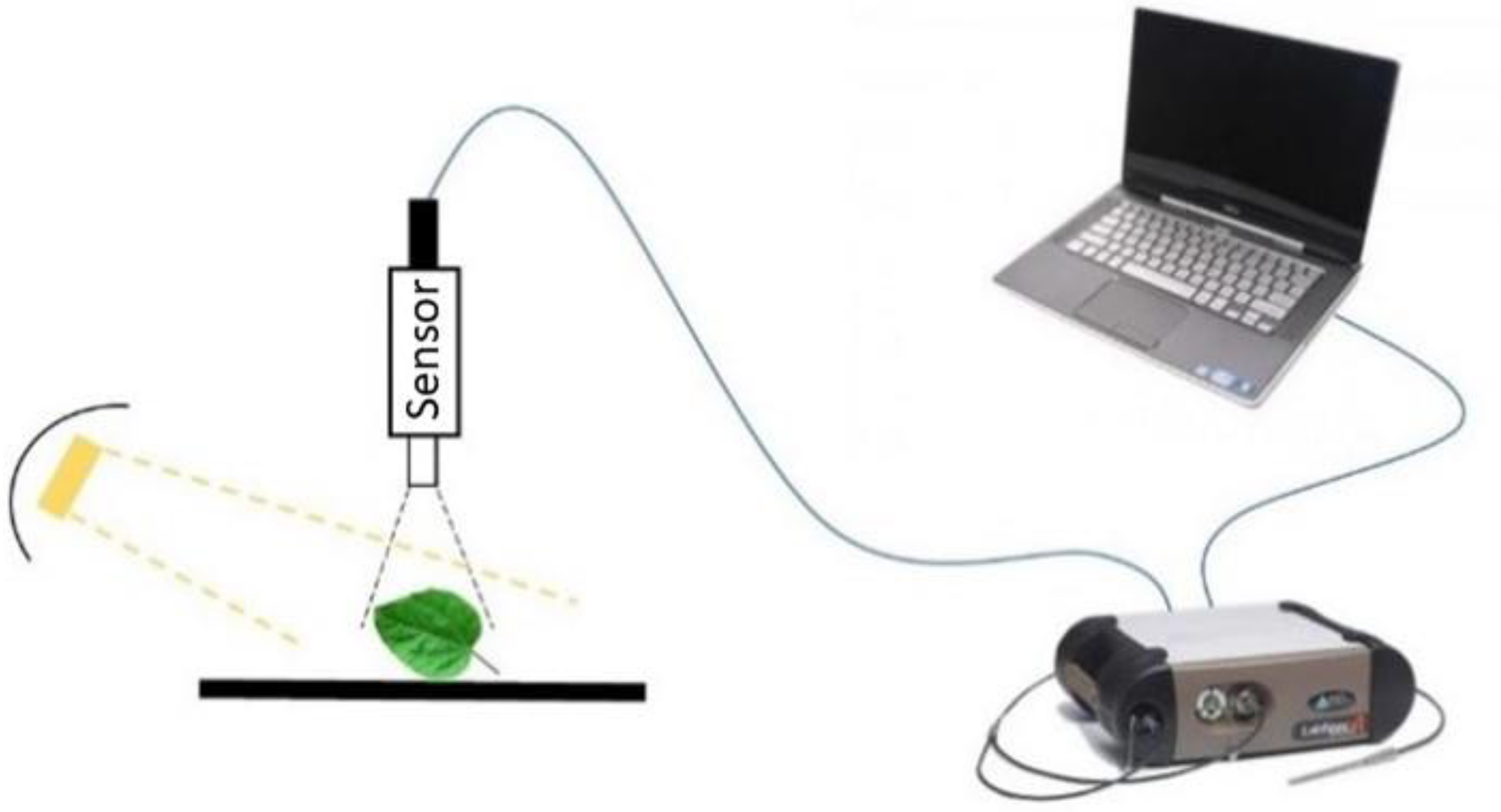
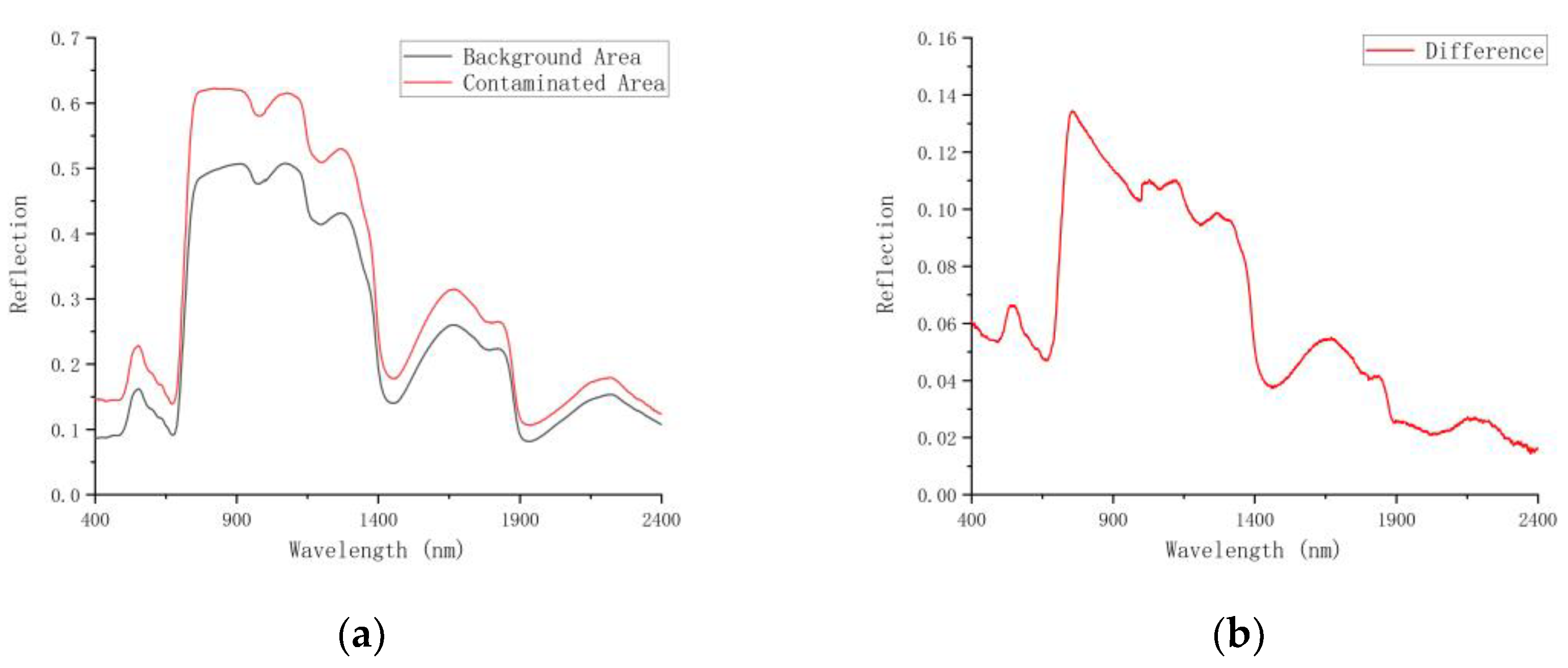
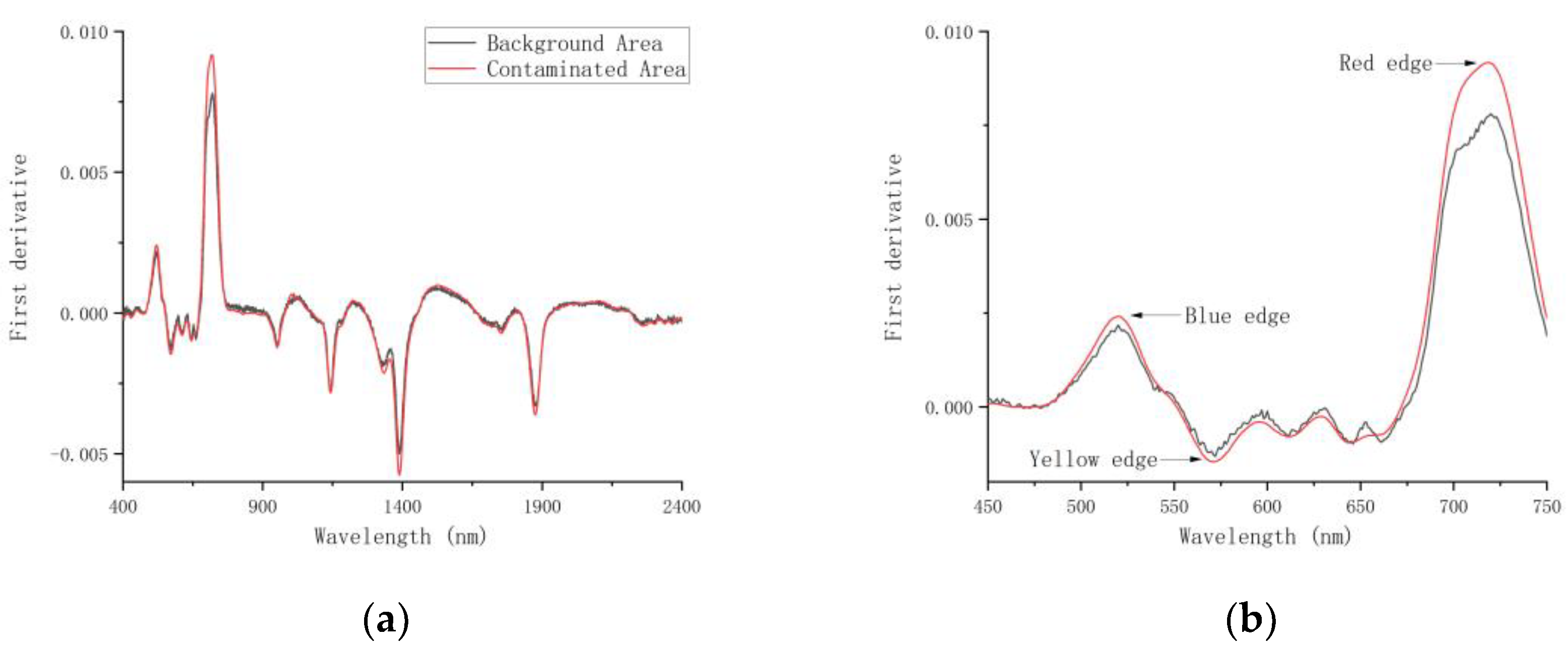
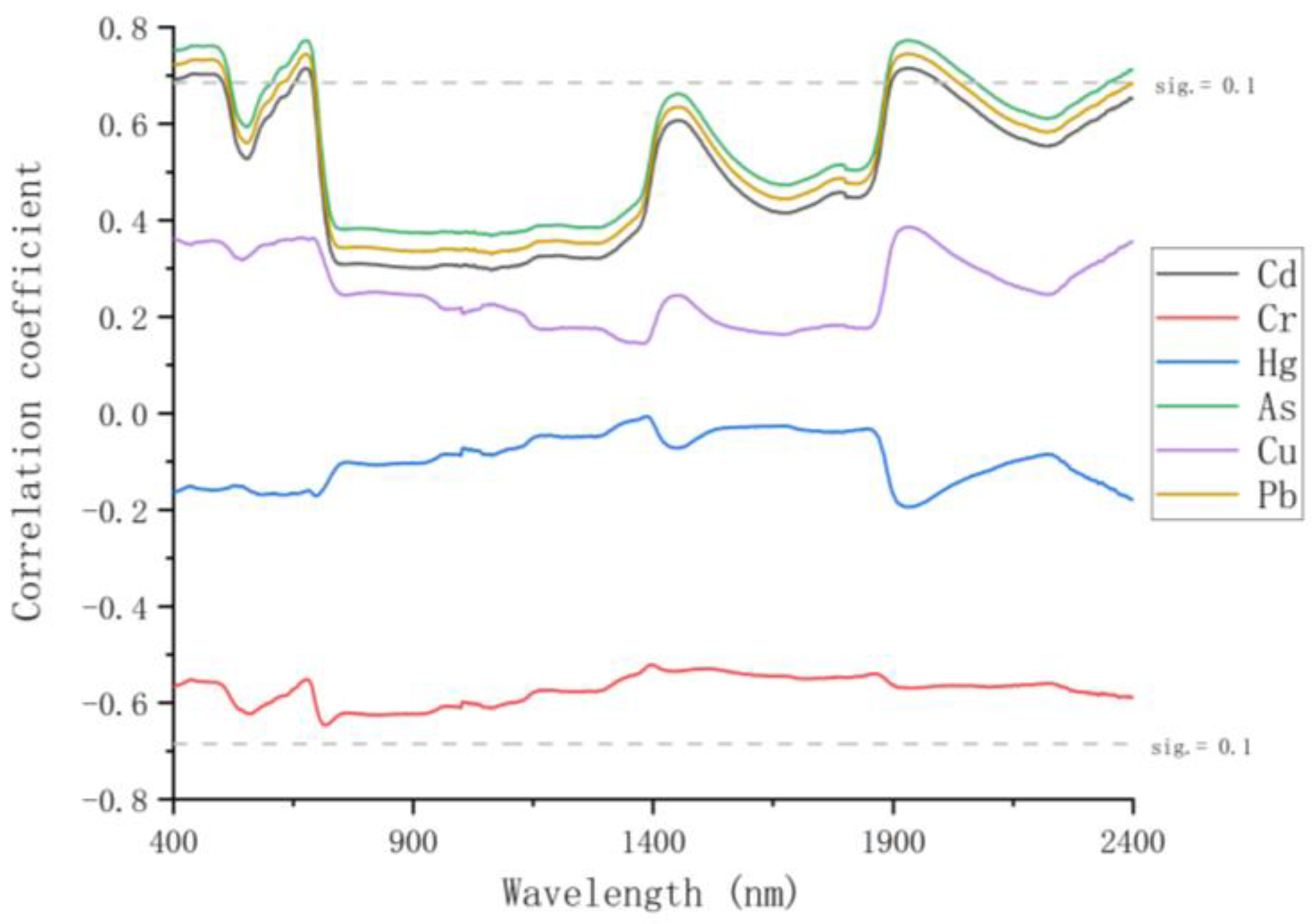
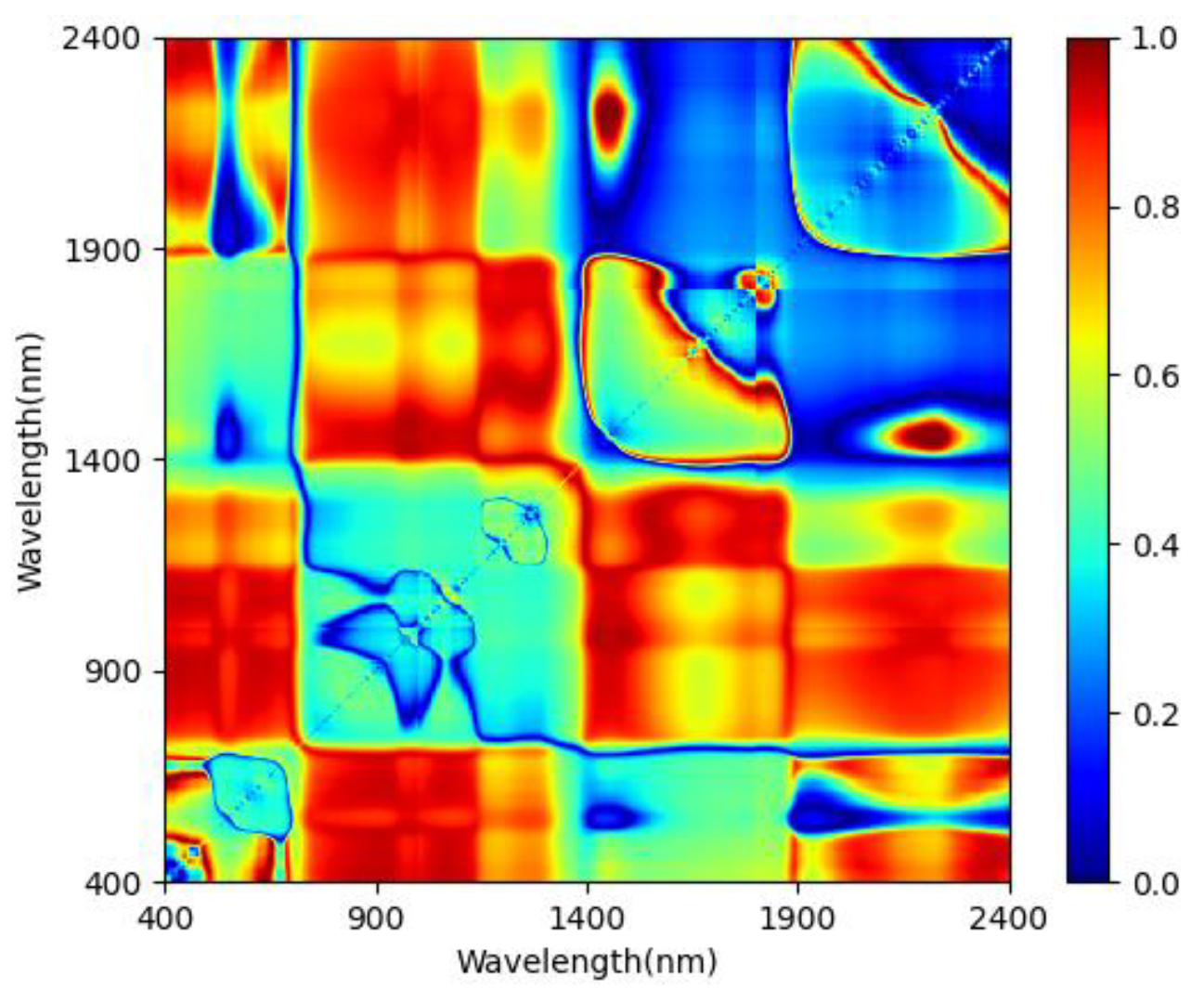
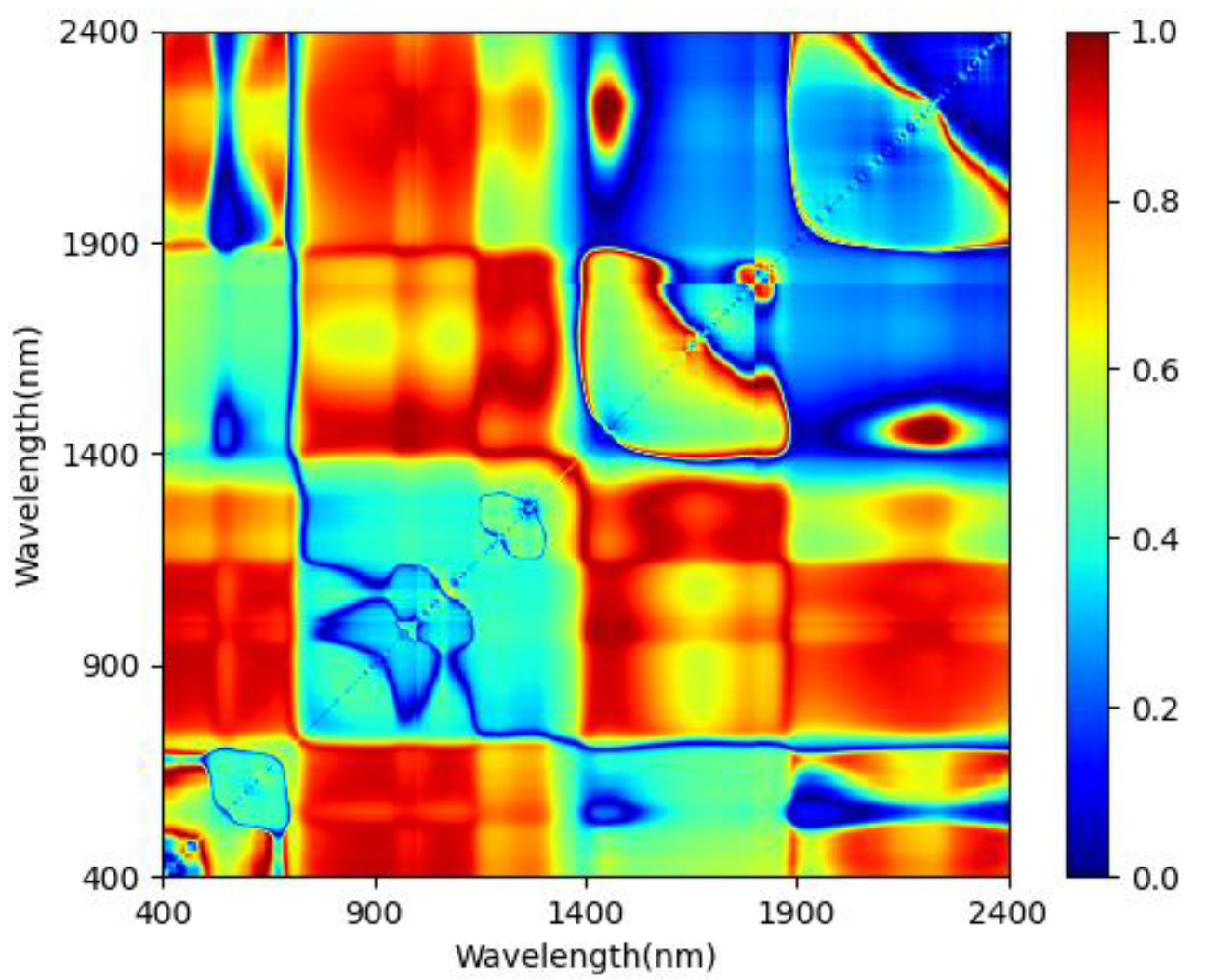

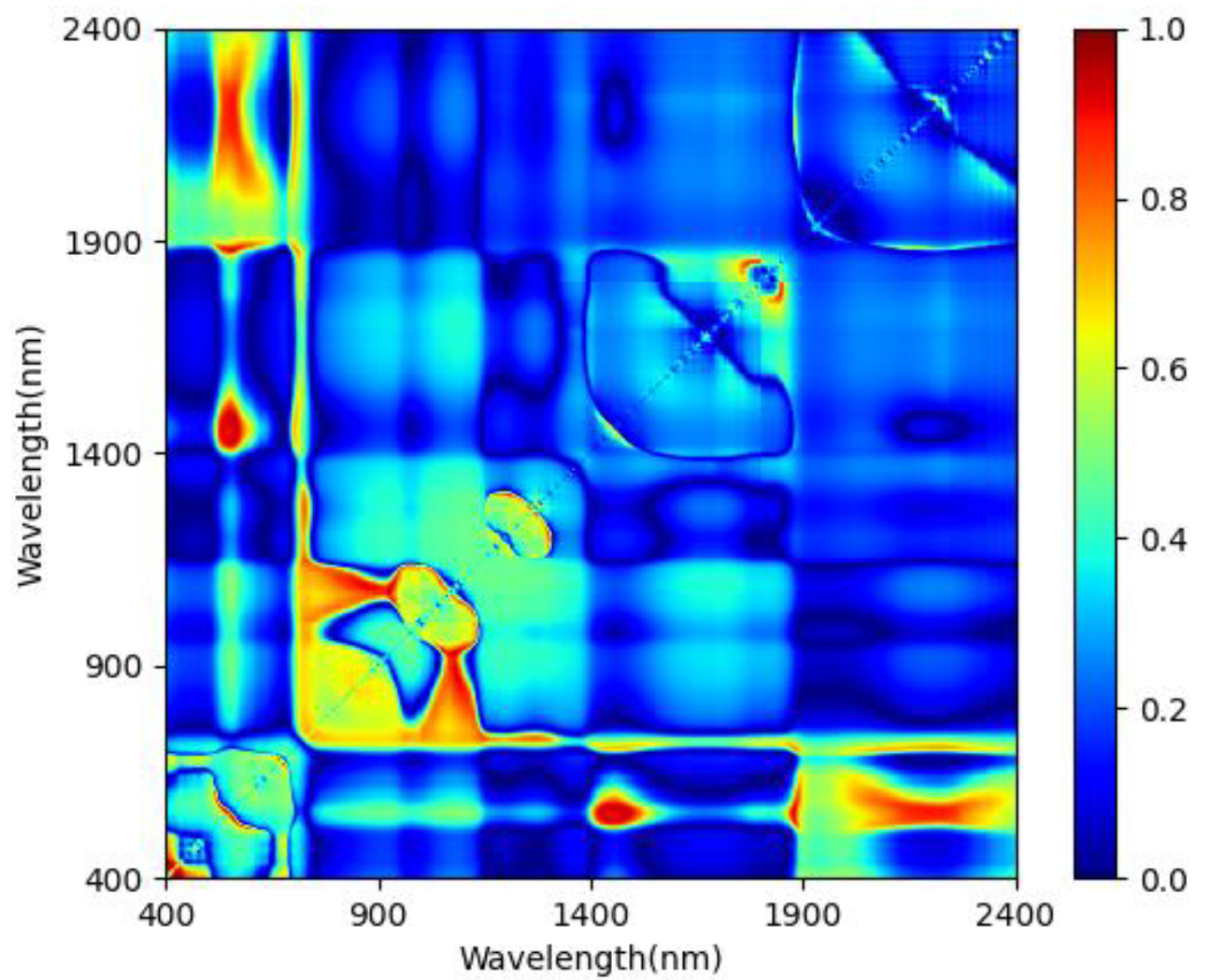
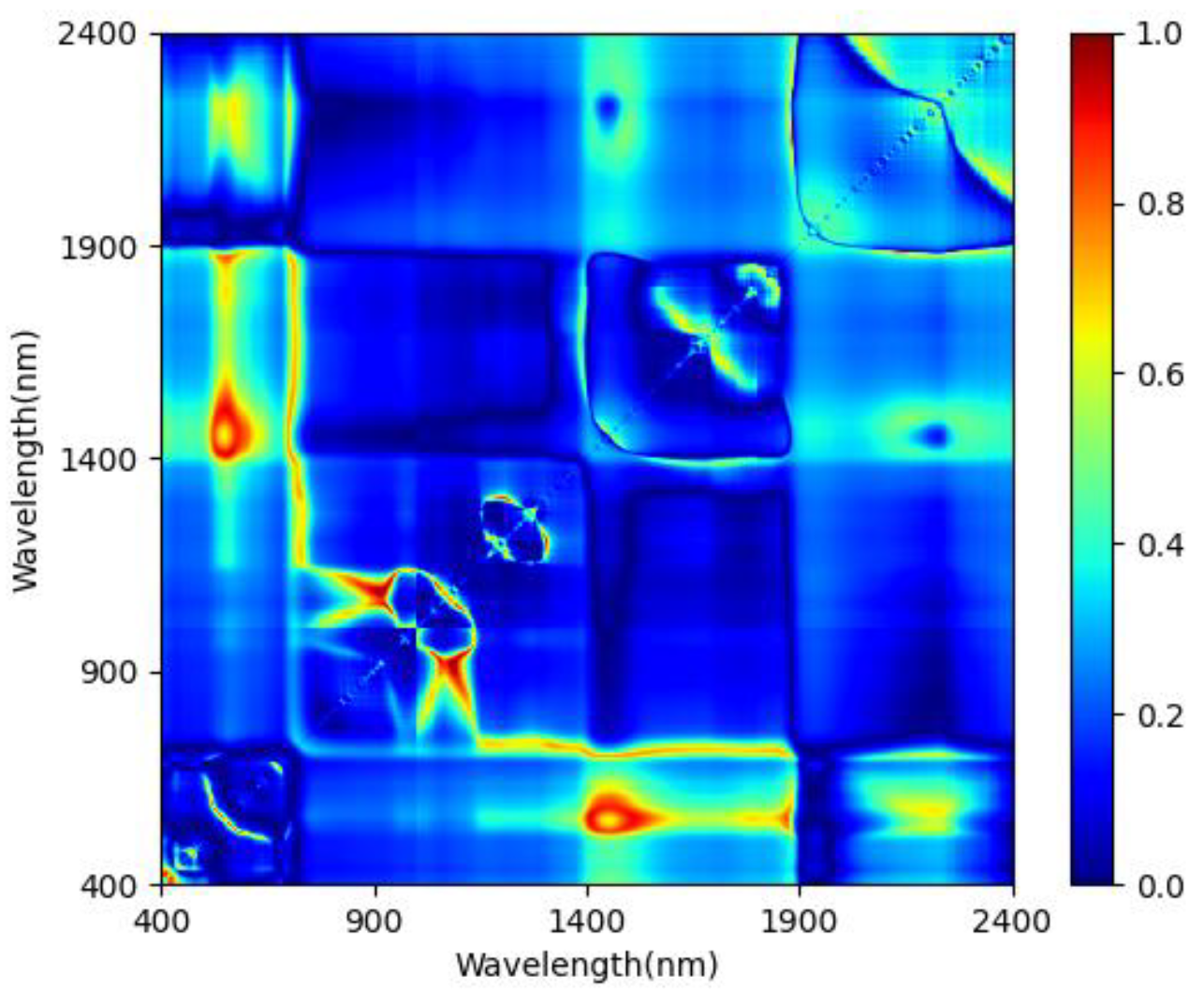
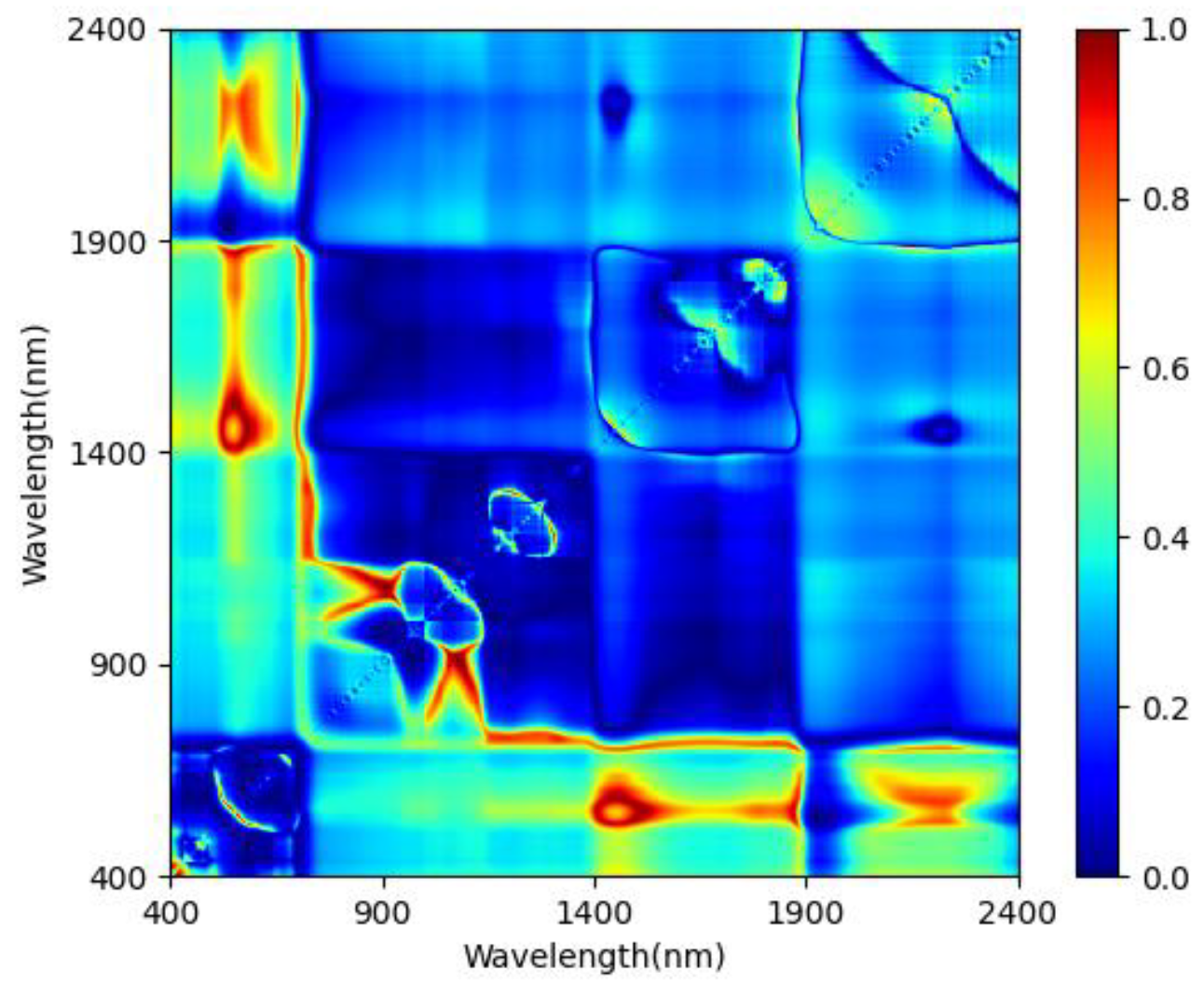

| Name of Spectral Index | Formula |
|---|---|
| Difference vegetation index (DVI) | – |
| Simple ratio vegetation index (SRVI) | |
| Normalized difference vegetation index (NDVI) | (– )/(+) |
| Inverse difference vegetation index (IDVI) | 1/− 1/ |
| Element | Maximum (mg/kg) | Minimum (mg/kg) | Mean (mg/kg) | Coefficient of Variation (%) | Background Value (mg/kg) | National Grade I Standard (mg/kg) | National Grade II Standard (mg/kg) |
|---|---|---|---|---|---|---|---|
| Cd | 0.76 | 0.09 | 0.27 | 58.71 | 0.12 | 0.20 | 0.30 |
| Cr | 172.99 | 52.85 | 82.81 | 24.88 | 56.47 | 90.00 | 250.00 |
| Hg | 0.24 | 0.02 | 0.06 | 57.65 | 0.04 | 0.15 | 0.30 |
| As | 132.96 | 7.75 | 28.70 | 90.85 | 8.14 | 15.00 | 30.00 |
| Cu | 53.60 | 22.18 | 31.07 | 23.08 | 18.50 | 35.00 | 50.00 |
| Pb | 497.24 | 20.36 | 91.41 | 90.83 | 13.78 | 35.00 | 300.00 |
| Heavy Metal | Cr (mg/kg) | Cu (mg/kg) | As (mg/kg) | Cd (mg/kg) | Pb (mg/kg) | Hg (mg/kg) |
|---|---|---|---|---|---|---|
| Polluted Area | 74.85 | 29.44 | 34.36 | 0.28 | 94.45 | 0.06 |
| Background Area | 54.98 | 18.04 | 8.03 | 0.11 | 10.16 | 0.03 |
| Heavy Metal Element | Spectral Index | λ1 | λ2 | Correlation Coefficient |
|---|---|---|---|---|
| As | DVI | 655 | 480 | 0.711 ** |
| SRVI | 605 | 603 | 0.705 * | |
| NDSI | 605 | 603 | 0.709 ** | |
| IDVI | 877 | 876 | 0.707 * | |
| Pb | DVI | 651 | 451 | 0.711 ** |
| SRVI | 604 | 603 | 0.702 * | |
| NDSI | 604 | 603 | 0.705 ** | |
| IDVI | 877 | 876 | 0.703 * | |
| Cd | DVI | 646 | 432 | 0.711 ** |
| SRVI | 604 | 603 | 0.706 * | |
| NDSI | 604 | 603 | 0.707 ** | |
| IDVI | 877 | 876 | 0.703 * | |
| Cr | DVI | 572 | 528 | 0.699 * |
| SRVI | 410 | 403 | 0.693 * | |
| NDSI | 410 | 403 | 0.695 * | |
| IDVI | 407 | 401 | 0.681 * | |
| Hg | DVI | 914 | 786 | 0.687 * |
| SRVI | 561 | 541 | 0.683 * | |
| NDSI | 561 | 541 | 0.684 * | |
| IDVI | 918 | 915 | 0.678 * | |
| Cu | DVI | 596 | 520 | 0.700 * |
| SRVI | 560 | 544 | 0.694 * | |
| NDSI | 560 | 544 | 0.695 * | |
| IDVI | 554 | 552 | 0.681 * |
| Heavy Metal | Spectral Index | Linear Model | R2 | RMSE |
|---|---|---|---|---|
| As | R655-R480 | Y = −2772.418X + 59.774 | 0.612 * | 1.129 |
| Pb | R651-R451 | Y = −6368.798X + 174.448 | 0.606 * | 1.235 |
| Cd | R646-R432 | Y = −8.610X + 0.435 | 0.599 * | 1.298 |
| Cr | R572-R528 | Y = −5066.048X + 99.189 | 0.554 | 2.346 |
| Hg | R914-R786 | Y = 0.164X + 0.051 | 0.537 | 2.547 |
| Cu | R596-R520 | Y = 1039.642X + 24.706 | 0.566 | 3.336 |
| Heavy Metal | Multiple Regression Model |
|---|---|
| As | y = 40.655 + 18.587 × DVI − 178.328 × NDSI + 3.578 × Blue − 10.225 × Red + 11.6 × Near-infrared |
| Pb | y = 102.690 + 54.176 × DVI − 480.779 × NDSI + 16.729 × Blue − 44.332 × Red + 154.611 × Near-infrared |
| Cd | y = 0.267 + 0.073 × DVI − 0.547 × NDSI + 0.032 × Blue − 0.047 × Red − 0.116 × Near-infrared |
Publisher’s Note: MDPI stays neutral with regard to jurisdictional claims in published maps and institutional affiliations. |
© 2021 by the authors. Licensee MDPI, Basel, Switzerland. This article is an open access article distributed under the terms and conditions of the Creative Commons Attribution (CC BY) license (https://creativecommons.org/licenses/by/4.0/).
Share and Cite
Liu, W.; Yu, Q.; Niu, T.; Yang, L.; Liu, H. Inversion of Soil Heavy Metal Content Based on Spectral Characteristics of Peach Trees. Forests 2021, 12, 1208. https://doi.org/10.3390/f12091208
Liu W, Yu Q, Niu T, Yang L, Liu H. Inversion of Soil Heavy Metal Content Based on Spectral Characteristics of Peach Trees. Forests. 2021; 12(9):1208. https://doi.org/10.3390/f12091208
Chicago/Turabian StyleLiu, Wei, Qiang Yu, Teng Niu, Linzhe Yang, and Hongjun Liu. 2021. "Inversion of Soil Heavy Metal Content Based on Spectral Characteristics of Peach Trees" Forests 12, no. 9: 1208. https://doi.org/10.3390/f12091208






